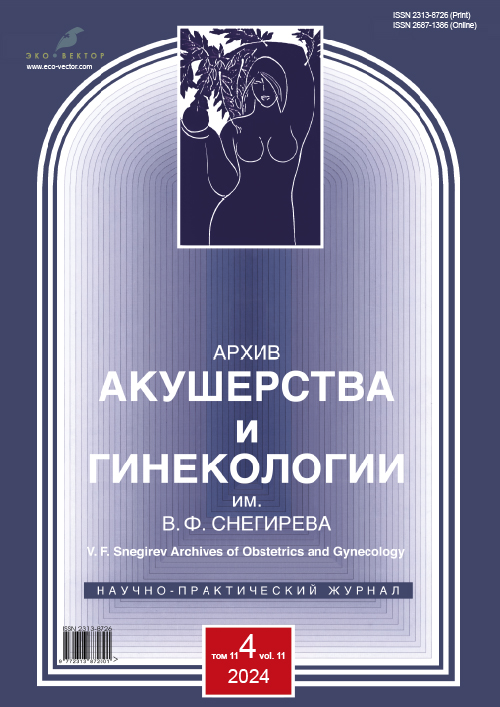子宫颈上皮内瘤变的风险因素
- 作者: Anisimova M.A.1, Shcherbakova L.N.1, Bugerenko A.E.1, Jain M.1, Kirillova K.I.1, Samokhodskaya L.M.1, Panina O.B.1
-
隶属关系:
- Lomonosov Moscow State University
- 期: 卷 11, 编号 4 (2024)
- 页面: 480-489
- 栏目: Original study articles
- ##submission.dateSubmitted##: 24.06.2024
- ##submission.dateAccepted##: 25.07.2024
- ##submission.datePublished##: 22.12.2024
- URL: https://archivog.com/2313-8726/article/view/633744
- DOI: https://doi.org/10.17816/aog633744
- ID: 633744
如何引用文章
详细
背景。子宫颈上皮内瘤变的主要病因与人乳头瘤病毒(HPV)的持续感染密切相关。流行病学研究表明,HPV感染的发生率远高于子宫颈上皮内瘤变的发生率,因此,HPV检测在识别高等级子宫颈上皮内瘤变方面的特异性和阳性预测价值仍有限。目前,针对HPV阳性女性的筛查策略尚未明确,其关键在于识别真正处于高风险中的人群。
研究目的。评估与子宫颈上皮内瘤变风险增加相关的社会经济、行为及合并症因素。
材料与方法。研究对象包括121名于2022–2023年间前往莫斯科国立大学医学科学教育中心就诊的女性患者。根据宫颈细胞学检查结果,患者分为三组:第1组(NILM,66名)细胞学检查正常;第2组(LSIL,27名)轻度子宫颈上皮内瘤变;第3组(HSIL,28名)重度子宫颈上皮内瘤变。所有患者均接受了详细的病史调查、液基细胞学检查及HPV分型分析。统计分析使用MedCalc软件完成。
结果。数据分析显示,以下因素显著增加重度子宫颈上皮内瘤变的风险:年龄超过30岁 (风险增加5.4倍)、吸烟(3.4倍)、性行为时间超过10年(9.9倍)、性伴侣数量超过4人(6.3倍)、使用体外排精法(Postcoital Pull-out Attempt,PPA)避孕(4.1倍)、妊娠次数达到3次及以上(7.0倍)、持续HPV感染(4.7倍),尤其是HPV 16型感染(4.3倍)。在子宫颈上皮内瘤变患者中,高危型HPV感染更为常见(LSIL组88.9%,HSIL组85.7%,NILM组56.1%),且超过一半的HSIL患者感染了HPV 16型。
结论。在研究样本中,子宫颈上皮内瘤变的风险与以下因素显著相关:年龄超过30岁、吸烟、性行为超过10年、性伴侣数量超过4人、缺乏屏障避孕、多次妊娠史以及持续高危型HPV感染(尤其是HPV 16型感染)。这些因素的识别对高危人群的筛查及干预具有重要意义。
全文:
作者简介
Maria A. Anisimova
Lomonosov Moscow State University
编辑信件的主要联系方式.
Email: manecha35@mail.ru
ORCID iD: 0009-0002-6081-5597
SPIN 代码: 9561-8400
Graduate Student
俄罗斯联邦, MoscowLiya N. Shcherbakova
Lomonosov Moscow State University
Email: liya.fbm@gmail.com
ORCID iD: 0000-0003-2681-4777
SPIN 代码: 3138-4565
MD, Dr. Sci. (Medicine), Professor
俄罗斯联邦, MoscowAndrey E. Bugerenko
Lomonosov Moscow State University
Email: jeddit@yandex.ru
ORCID iD: 0000-0001-5691-7588
SPIN 代码: 5827-0440
MD, Dr. Sci. (Medicine), Assistant Professor
俄罗斯联邦, MoscowMark Jain
Lomonosov Moscow State University
Email: jain-mark@outlook.com
ORCID iD: 0000-0002-6594-8113
SPIN 代码: 3783-4441
Senior Research Associate
俄罗斯联邦, MoscowKarina I. Kirillova
Lomonosov Moscow State University
Email: dkkirillova@gmail.com
ORCID iD: 0000-0002-0873-7387
SPIN 代码: 4440-1859
Research Associate
俄罗斯联邦, MoscowLarisa M. Samokhodskaya
Lomonosov Moscow State University
Email: slm@fbm.msu.ru
ORCID iD: 0000-0001-6734-3989
SPIN 代码: 5404-6202
MD, Cand. Sci. (Medicine)
俄罗斯联邦, MoscowOlga B. Panina
Lomonosov Moscow State University
Email: olgapanina@yandex.ru
ORCID iD: 0000-0003-1397-6208
SPIN 代码: 2105-6871
MD, Dr. Sci. (Medicine), Professor
俄罗斯联邦, Moscow参考
- Singh D, Vignat J, Lorenzoni V, et al. Global estimates of incidence and mortality of cervical cancer in 2020: a baseline analysis of the WHO global cervical cancer elimination initiative. Lancet Glob Health. 2023;11(2):e197–e206. doi: 10.1016/S2214-109X(22)00501-0
- Kaczmarek M, Baj-Krzyworzeka M, Bogucki Ł, Dutsch-Wicherek M. HPV-related cervical cancer and extracellular vesicles. Diagnostics. 2022;12(11):2584. doi: 10.3390/diagnostics12112584
- Ershov VA. Concepts of the genesis of HPV-associated cervical cancer. Russian News of Clinical Cytology. 2021;25(1):20–29. EDN: KTZKMN doi: 10.24412/1562-4943-2021-1-0004
- Faizuloev EB, Kaira AN, Uzbekov TR, et al. The prevalence of high- and low-risk human papillomaviruses in the Russian Federation. Molecular Genetics, Microbiology and Virology. 2021;39(4):39–47. EDN: BJPTLV doi: 10.17116/molgen20213904139
- Bogani G, Taverna F, Lombardo C, et al. Retrospective study of the influence of HPV persistence on outcomes among women with high-risk HPV infections and negative cytology. Int J Gynaecol Obstet. 2017;138(1):62–68. doi: 10.1002/ijgo.12170
- Prisyazhnaya TS, Mikhaylyukova VA, Berlev IV, Malek AV. Risk factors modulating the course of low-grade squamous intraepithelial lesions in women of reproductive age. Tumors of the Female Reproductive System. 2021;17(1):45–52. EDN: MLWJSR doi: 0.17650/1994-4098-2021-17-1-45-52
- Bowden SJ, Doulgeraki T, Bouras E, et al. Risk factors for human papillomavirus infection, cervical intraepithelial neoplasia and cervical cancer: an umbrella review and follow-up Mendelian randomisation studies. BMC Medicine. 2023;21(1):274. doi: 10.1186/s12916-023-02965-w
- Hortlund M, Mol T, Pol FV, et al. Human papillomavirus load and genotype analysis improves the prediction of invasive cervical cancer. Int J Cancer. 2021;149(3):684–691. doi: 10.1002/ijc.33519
- Lam JUH, Rebolj M, Dugue PA, et al. Condom use in prevention of human papillomavirus infections and cervical neoplasia: systematic review of longitudinal studies. J Med Screen. 2014;21(1):38–50. doi: 10.1177/0969141314522454
- Order of the Ministry of Health of the Russian Federation dated 10/20/2020 No. 1130n “On approval of the Procedure for providing medical care in the field of obstetrics and gynecology”. Publication number: 0001202011130037. Date of publication: 11/13/2020. Available from: http://publication.pravo.gov.ru/Document/View/0001202011130037 (In Russ.)
- Feng Q, Balasubramanian A, Hawes SE, et al. Detection of hypermethylated genes in women with and without cervical neoplasia. J Natl Cancer Inst. 2005;97(4):273–282. doi: 10.1093/JNCI/DJI041
- Wei L, Griego AM, Chu M, Ozbun MA. Tobacco exposure results in increased E6 and E7 oncogene expression, DNA damage and mutation rates in cells maintaining episomal human papillomavirus 16 genomes. Carcinogenesis. 2014;35(10): 2373–2381. doi: 10.1093/carcin/bgu156
- Stumbar SE, Stevens M, Feld Z. Cervical cancer and its precursors: a preventative approach to screening, diagnosis, and management. Prim Care. 2019:46(1):117–134. doi: 10.1016/j.pop.2018.10.011
- Anufrieva VG, Lebedenko EY, Gaida OV, et al. Manageable risk factors for progression of HPV-associated cervical intraepithelial neoplasia. Medical Herald of the South of Russia. 2022;13(2):34–43. EDN: FHPXMW doi: 10.21886/2219-8075-2022-13-2-34-43
- Loopik DL, IntHout J, Melchers WJG, et al. Oral contraceptive and intrauterine device use and the risk of cervical intraepithelial neoplasia grade III or worse: a population-based study. Eur J Cancer. 2020;124:102–109. doi: 10.1016/j.ejca.2019.10.009
- Levakov SA, Sheshukova NA, Dabagyan LS. Prevalence and risk factors of cervical intra-epithelial neoplasia. Gynecology, Obstetrics and Perinatology. 2017;16(5):94-100. EDN: ZUKEVJ doi: 10.20953/1726-1678-2017-5-94-100
- Pimple S, Mishra G. Cancer cervix: epidemiology and disease burden. Cytojournal. 2022;19:21. doi: 10.25259/CMAS_03_02_2021
补充文件






